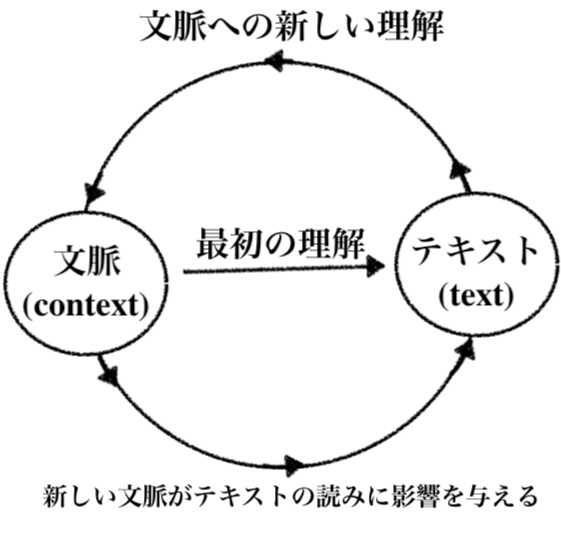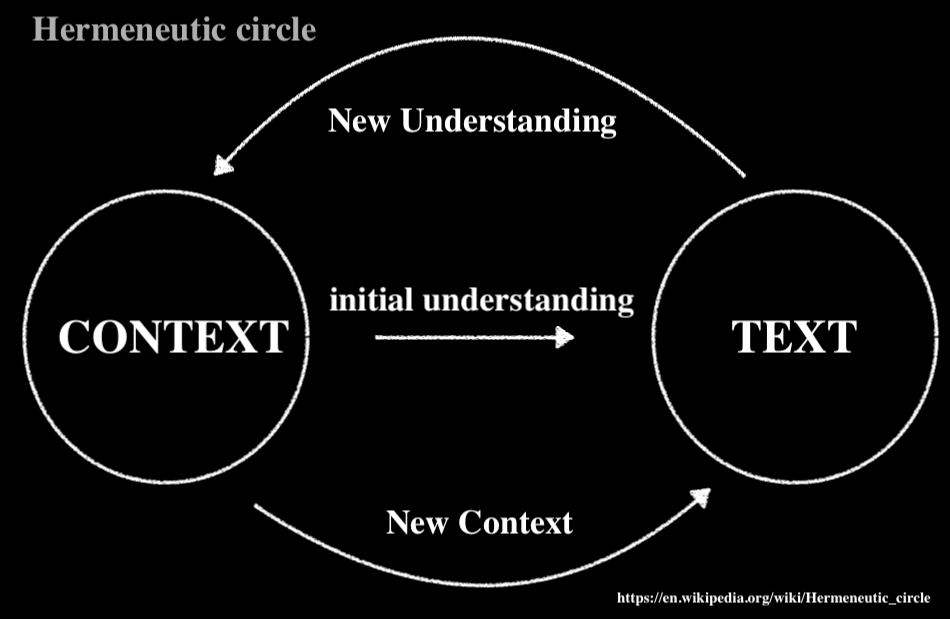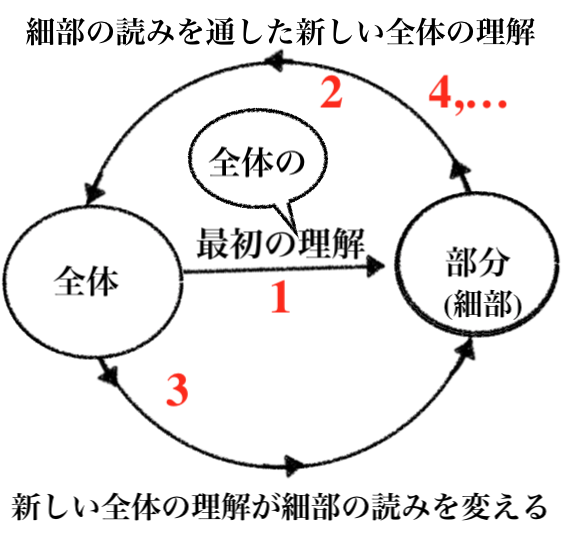解釈学的循環・解釈学的円環
Hermeneutischer Zirkel, Hermeneutic circle
解釈学的循環・解釈学的円環
Hermeneutischer Zirkel, Hermeneutic circle
04■解釈学的循環あるいは解釈学的円環 (Hermeneutischer Zirkel, Hermeneutic circle)
"The hermeneutic circle (German: hermeneutischer Zirkel) describes the process of understanding a text hermeneutically. It refers to the idea that one's understanding of the text as a whole is established by reference to the individual parts and one's understanding of each individual part by reference to the whole. Neither the whole text nor any individual part can be understood without reference to one another, and hence, it is a circle. However, this circular character of interpretation does not make it impossible to interpret a text; rather, it stresses that the meaning of a text must be found within its cultural, historical, and literary context." - Hermeneutic circle.
解釈学的循環(ドイツ語:
hermeneutischer
Zirkel)とは、テキストを解釈学的に理解するプロセスを説明するものである。これは、テキスト全体に対する理解は個々の部分への言及によって、個々
の部分に対する理解は全体への言及によって確立されるという考え方のことである。テ
キスト全体も個々の部分も、互いに参照することなしに理解することはできず、それゆえ円環を描くことになる。しかし、このような解釈の循環
的な性格は、テキストを解釈することを不可能にするものではなく、むしろ、テキスト
の意味は、その文化的、歴史的、文学的文脈の中で見出されなければならないことを強調するものである。
「ディルタイは、その解釈学において、(1)全体の理解は 部分の理解に依存し、部分の理解は全体の理解に依存する、ということを指摘し、全体や部分の解釈が循環に陥ることを問題にした。/これに対し、(2)ハイデガー はこの循環を時間性として捉え、先入見(Vorurteil)がむしろ必要不可欠であると考えた。/(3)ガダマーは、ハイデガーの思想を発展させつつもその時 間性を排し、この循環を積極的に地平融合として理解した。すなわち、この地平融合において、元著者のテキストと解釈者のテキストはどちらが優位ということ なく融合して一体化する」と考える(ウィキ日本語より)【→ハイパーテキスト】。
引用は、ギアツからのものである。
"It refers to the idea that one's understanding of the text as a whole is established by reference to the individual parts and one's understanding of each individual part by reference to the whole. Neither the whole text nor any individual part can be understood without reference to one another, and hence, it is a circle. However, this circular character of interpretation does not make it impossible to interpret a text; rather, it stresses that the meaning of a text must be found within its cultural, historical, and literary context."
これは、テキスト全体に対する理解は個々の部分への 言及によって、個々の部分に対する理解は全体への言及によって確立されるという考え方のことである。テキスト全体も個々の部分も、互いに参照することなし に理解することはできず、それゆえ円環を描くことになる。しかし、このような解釈の循環的な性格は、テキストを解釈することを不可能にするものではなく、 むしろ、テキストの意味は、その文化的、歴史的、文学的文脈の中で見出されなければならないことを強調するものである。



☆Der Ausdruck vom hermeneutischer Zirkel
| Der Ausdruck vom
hermeneutischen Zirkel (von altgriechisch ἑρμηνεύω hermēneúō
„übersetzen, erklären, auslegen“) ist eine zunächst visuelle
Vergegenständlichung der zwischen Autor und Rezipient widersprüchlichen
Interpretationssituation und der geisteswissenschaftlichen Bemühungen
zu ihrer Überbrückung, u. a. in Bezug auf Texte geschichtlichen oder
psychologischen Inhalts oder auf Kunstwerke. |
解釈学的な循環(古代ギリシャ語の ἑρμηνεύω
hermēneúō
「翻訳する、説明する、解釈する」から派生)という用語は、作者と受容者の間で生じる解釈上の矛盾、およびそれを解消しようとする人文科学の努力を、まず
視覚的に具体化したものである。これは、歴史的または心理的な内容を含むテキストや芸術作品などに関連して用いられる。 |
| Hintergrund Das Verstehen des Sinns kultureller Äußerungen (Darstellungen, Kunstwerke, Texte usw.) ist an bestimmte Vorbedingungen (Vorwissen und Vorannahmen, Werturteile, Begriffsschemata usw.) von Interpreten gebunden, die im Regelfall nicht mit jenen der Produzenten deckungsgleich sind. Der Prozess der Annäherung beider „Verstehenshorizonte“ ist fortschreitend und schließt niemals ab. Die Vorstellung eines Zirkels (d. h. einer Kreisbewegung) entspricht dabei der Tatsache, dass es keinen objektiven, von sicherem Standort beginnenden und linearen, direkt zielführenden Weg zum Sinn eines Textes oder Kunstwerks gibt, sondern der Verstehende sich erstens bereits in einer verstehenden Annäherungsbewegung befindet und sich dabei zweitens, wenn er sich nicht ohnehin nur „im eigenen Kreise dreht“, dem Verstehensziel bestenfalls in einer Spiralbewegung annähern kann, ohne doch je zu einem vollständigen „Verständnis“ des Objektes seines Interesses gelangen zu können. Die These vom hermeneutischen Zirkel als Voraussetzung der hermeneutischen Methode wurde wohl erstmals von dem Altphilologen Friedrich Ast (1778–1841) aufgestellt und 1808 veröffentlicht: „Wenn wir nun aber den Geist des gesamten Altertums nur durch seine Offenbarungen in den Werken der Schriftsteller erkennen können, diese aber selbst wieder die Erkenntnis des universellen Geistes voraussetzen, wie ist es möglich, da wir immer nur das eine nach dem anderen, nicht aber das Ganze zu gleicher Zeit auffassen können, das Einzelne zu erkennen, da dieses die Erkenntnis des Ganzen voraussetzt? Der Zirkel, dass ich a, b, c usw. [= die Werke einzelner Autoren] nur durch A [= der „Geist des Alterthums“] erkennen kann, aber dieses A selbst wieder nur durch a, b, c usf., ist unauflöslich, wenn beide A und a, b, c als Gegensätze gedacht werden, die sich wechselseitig bedingen und voraussetzen, nicht aber ihre Einheit anerkannt wird, so dass A nicht erst aus a, b, c usf. hervorgeht und durch sie gebildet wird, sondern ihnen selbst vorausgeht, sie alle auf gleiche Weise durchdringt, a, b, c also nichts anderes als individuelle Darstellungen des Einen A sind. In A liegen dann auf ursprüngliche Weise schon a, b, c; diese Glieder selbst sind die einzelnen Entfaltungen des Einen A, also liegt in jedem auf besondere Weise schon A, und ich brauche nicht erst die ganze unendliche Reihe der Einzelnheiten zu durchlaufen, um ihre Einheit zu finden.“ – Friedrich Ast, Grundlinien der Grammatik, Hermeneutik und Kritik[1] |
背景 文化的表現(表現、芸術作品、テキストなど)の意味を理解するには、解釈者による特定の条件(予備知識や前提、価値判断、概念体系など)が不可欠であり、 通常、それらは制作者による条件とは一致しない。両者の「理解の視野」を近づけるプロセスは進行中であり、決して完結することはない。円(つまり円運動) の概念は、テキストや芸術作品の意味を理解するための、客観的で確実な出発点から直線的に目標に到達する道など存在せず、理解者はまず、理解に向けて接近 する動きの中にあり、その動きの中で、単に「自分の円の中で回転している」だけではない場合、 理解の目標には、せいぜい螺旋状の動きで近づくことができるだけで、その対象を完全に「理解」することは決してできない。 解釈学的方法の前提となる解釈学的循環の説は、古典学者フリードリッヒ・アスト(1778-1841)によって初めて提唱され、1808年に発表された。 「しかし、古代全体の精神は、作家たちの作品に表れているものを通してしか認識できないが、その作品自体も、普遍的な精神の認識を前提としている。我々 は、常に一つずつしか理解できず、時代を同時に理解することはできないのに、時代を理解することを前提とする個別を理解することは、どうして可能だろう か?a、b、c など(個々の作家の作品)は A(「古代の精神」)によってのみ認識できるが、この A 自体は a、b、c などによってのみ認識できる、という循環論法は、A と a、b、c を相互に条件付け、相互に前提とする対立概念として考える場合、両者の統一性を認めないため、解決できない。A と a、b、c が相互に条件付け、前提とする対極として考えられ、その統一性が認識されない場合、この循環は解決できない。つまり、A は a、b、c などから生まれ、それらによって形成されるのではなく、それらに先行し、それらすべてに等しく浸透しており、a、b、c は、単一の A の個別の表現にすぎない。A には、もともと a、b、c がすでに存在している。これらの要素は、単一の A の個々の展開である。つまり、それぞれには特別な形で A がすでに存在しており、その統一性を見つけるために、無限の細部の系列をすべて辿る必要はない。 – フリードリッヒ・アスト、『文法、解釈学、批評の基礎』[1] |
| Die hermeneutische Methode In der Erkenntnistheorie ist vor allem der von Martin Heidegger in Sein und Zeit dargestellte Ansatz bedeutsam geworden, der den hermeneutischen Zirkel „ontologisch“ begründen will.[2] Danach liegt der Anfang des hermeneutischen Zirkels in einer ursprünglichen Grundevidenz der Wahrheit. Nur weil der Mensch „immer schon“ in der Wahrheit seines Seins stehe, könne er die Wahrheitsfrage über den Sinn seines Menschseins stellen und diese weiter ausbauen. Demzufolge ist jede Aussage, die von einem Individuum getroffen wird, für dasselbige ein hermeneutischer Zirkel, da dieses sowohl die Wahrheit als auch die „Erkenntnis“ der Wahrheit schon innehat, oder anders formuliert, sich die Frage nach der Wahrheit nicht stellen kann, da es diese ja schon ist. Diese Auffassung hat Hans-Georg Gadamer in seiner Hermeneutik weiterentwickelt. Grundlage der Interpretation ist die Ergriffenheit des Lesers. Dementsprechend sind Gebrauchstexte von der hermeneutischen Methode ausgeschlossen. Emil Staiger umschrieb dies folgendermaßen: „Dass wir begreifen, was uns ergreift.“ (Emotionales muss rational erklärt werden, Faszination führt zu Analyse.) Der eigentliche Verstehensprozess besteht dann aus 1. der Bildung von Vorurteilen (d. h. Vorwegnahmen oder Vorannahmen), in denen Vermutungen über den Sinn eines Textes (oder eines Textabschnittes) vorausgeworfen werden; 2. der anschließenden Erarbeitung des Textes (oder Textabschnittes). Dieser Prozess führt zur Änderung und Weiterentwicklung des ursprünglichen Vorwissens, die Bereitschaft zur Revision der eigenen Vorurteile vorausgesetzt (vgl. Offenheit, Empfänglichkeit bei Gadamer).[3] Herausschälbar sind drei Stadien und ein Vorstadium: Vorstadium: Herausbildung eines Vorverständnisses, Meisterung der Sprache, Vorstellung über äußere Bedingungen eines Textes Der hermeneutische Entwurf (erstes Stadium): Horizontverschmelzung zwischen Verstehenshorizont und Bedeutungshorizont Die hermeneutische Erfahrung (zweites Stadium): Vorverständnis wird erweitert und korrigiert Der verbesserte Entwurf (drittes Stadium): Tieferes Verständnis, Reifung des Vorverständnisses Mit diesem überarbeiteten Vorverständnis kann der Verstehensprozess erneut angestoßen werden, so dass die vorausliegenden Stadien nochmals durchlaufen werden. Im Prinzip kann dieser Kreis endlos wiederholt werden. Der hermeneutische Zirkel wird oft als Methode sui generis in den Geisteswissenschaften verstanden, durch die sich die Geisteswissenschaften von den Naturwissenschaften unterscheiden. Der analytische Wissenschaftsphilosoph Wolfgang Stegmüller hat allerdings eingewendet, dass das Bild des hermeneutischen Zirkels erstens keinen Zirkel beschreibt (sondern eine „hermeneutische Spirale“), zweitens keine Methode ist und drittens kein Unterscheidungsmerkmal zwischen geisteswissenschaftlicher und naturwissenschaftlicher Erkenntnis darstellt. |
解釈学的方法 認識論では、とりわけ、マルティン・ハイデガーが『存在と時代』で提示した、解釈学の循環を「存在論的に」立証しようとするアプローチが重要となってい る。[2] それによれば、解釈学的な循環の始まりは、真実の根源的な基本証拠にある。人間は「常に」その存在の真実の中に立っているからこそ、人間であることの意義 について真実の問いを投げかけ、それをさらに発展させることができるのだ。したがって、個人が発するあらゆる発言は、その個人にとっては解釈学的循環であ る。なぜなら、その個人は真実と真実の「認識」の両方をすでに備えている、つまり、真実について疑問を抱くことができないからである。この見解は、ハン ス・ゲオルク・ガダマーが彼の解釈学でさらに発展させたものである。 解釈の基礎は、読者の感動である。したがって、実用的な文章は解釈学的方法から除外される。エミル・シュタイガーはこれを次のように表現している。「私た ちが感動するものを理解する」 (感情的なものは理性的に説明されなければならない、魅力は分析につながる)。実際の理解プロセスは、以下の要素で構成される。 1. 偏見(つまり、先入観や先入観)の形成。ここでは、テキスト(またはテキストの一部)の意味について推測が先取りされる。 2. その後、テキスト(またはテキストの一部)の理解が進められる。 このプロセスは、自分の先入観を修正する用意がある場合に、元の予備知識の変更と発展につながる(ガダマーの「開放性、受容性」を参照)。[3] 3 つの段階と 1 つの予備段階が区別できる。 予備段階:予備的な理解の形成、言語の習得、テキストの外部条件に関する想像 解釈学的草案(第一段階):理解の視野と意味の視野の融合 解釈学的経験(第二段階):事前理解の拡大と修正 改良された草案(第三段階):より深い理解、事前理解の成熟 この修正された予備的理解によって、理解のプロセスが再び開始され、先行する段階がもう一度繰り返される。原則として、この循環は際限なく繰り返される。 解釈学的循環は、人文科学を自然科学と区別する、人文科学特有の方法としてよく理解されている。しかし、分析的科学哲学者のヴォルフガング・シュテグミュ ラーは、解釈学的循環のイメージは、第一に循環(ではなく「解釈学的スパイラル」)を表しておらず、第二に方法論ではなく、第三に人文科学と自然科学の認 識を区別する特徴ではないと反論している。 |
| Bedeutung in der Postmoderne Für postmoderne Philosophen ist der hermeneutische Zirkel besonders problematisch. Sie glauben nicht nur, dass man die Welt nur durch die Worte erkennen kann, mit denen man sie beschreibt, sondern auch, dass „immer wenn Menschen eine bestimmte Interpretation eines Texts oder eines Ausdrucks festzulegen versuchen, sie andere Interpretationen als den Grund für ihre Interpretation behaupten“.[4] In anderen Worten: „Alle Bedeutungssysteme sind unabgeschlossene Systeme von Zeichen, die sich auf Zeichen beziehen. Kein Begriff kann daher eine letztgültige, eindeutige Bedeutung haben.“[5] |
ポストモダニズムにおける意味 ポストモダニズムの哲学者たちにとって、解釈の循環は特に問題である。彼らは、世界はそれを表現する言葉によってのみ認識できると信じているだけでなく、 「人々がテキストや表現の特定の解釈を確定しようとするときは、その解釈の根拠として他の解釈を主張する」とも信じている。[4] つまり、「すべての意味体系は、記号を参照する未完成の記号体系である。したがって、いかなる概念も、最終的な、明確な意味を持つことはできない」[5] ということだ。 |
| Heinrich Rombach |
ハインリッヒ・ロムバッハ |
| Literatur Karl-Otto Apel: Transformation der Philosophie, 2 Bände, Frankfurt am Main: Suhrkamp 1973 (Bd. I: Sprachanalytik, Semiotik, Hermeneutik; Bd. II: Das Apriori der Kommunikationsgemeinschaft) Wolfgang Stegmüller: Der sogenannte Zirkel des Verstehens. In: ders.: Das Problem der Induktion: Humes Herausforderung und moderne Antworten. Darmstadt 1996 (Wissenschaftliche Buchgesellschaft) |
文献 カール・オットー・アペル:哲学の変容、2巻、フランクフルト・アム・マイン:スールカンプ社 1973年(第1巻:言語分析、記号論、解釈学、第2巻:コミュニケーション共同体の先験性) ヴォルフガング・シュテグミュラー:いわゆる理解の循環。同著:帰納の問題:ヒュームの挑戦と現代的な答え。ダルムシュタット 1996年(科学書籍協会) |
| Einzelnachweise 1. Friedrich Ast: Grundlinien der Grammatik, Hermeneutik und Kritik. Landshut 1808, S. 179 f. 2. Martin Heidegger: Sein und Zeit, §§ 32 u. 63, Max Niemeyer Verlag, Tübingen 1926, 17. Auflage 1993, ISBN 3-484-70122-6, S. 152–154 u. 315 f. 3. Hans-Georg Gadamer: Wahrheit und Methode. Grundzüge einer philosophischen Hermeneutik. Gesammelte Werke, J.C.B. Mohr (Paul Siebeck), Tübingen 1990; Bd. I, Hermeneutik I, ISBN 3-16-145616-5 (a) zum Stichwort „Offenheit für die Meinung des anderen“: Teil II,1, S. 273; (b1) zum Stichwort „hermeneutischer Zirkel“: S. 179, 194, 270 ff., 296 ff.; Bd. II, Hermeneutik II, ISBN 3-16-146043-X (b2) = Forts. von (b1), weiter zum Stichwort „hermeneutischer Zirkel“: S. 34, 57 ff., 224 f.,331, 335, 357 f., 406. 4. Adler, E. 1997: "Seizing the Middle Ground: Constructivism in World Politics", European Journal of International Relations 3: 321–322 5. Wæver, Ole: The rise and fall of the inter-paradigm debate. In: Steve Smith et al.: International Theory: Positivism and Beyond. Cambridge 1996, S. 171. |
参考文献 1. フリードリッヒ・アスト:文法、解釈学、批評の基礎。ランドシュトゥット、1808年、179ページ以降。 2. マルティン・ハイデガー:存在と時間、§§ 32 および 63、マックス・ニーマイヤー出版社、テュービンゲン、1926年、1993年第17版、 ISBN 3-484-70122-6、152-154 および 315 ページ以降。 3. ハンス・ゲオルク・ガダマー『真実と方法。哲学的解釈学の基礎』。全集、J.C.B. モーア(ポール・ジーベック)、テュービンゲン、1990 年、第 I 巻、解釈学 I、 ISBN 3-16-145616-5 (a) 「他者の意見に対する開放性」のキーワードについて:第 II 部、1、273 ページ。(b1) 「解釈学的な循環」のキーワードについて:179、194、270 ページ以降、296 ページ以降。第 II 巻、解釈学 II、ISBN 3-16-146043-X (b2) = (b1) の続き、「解釈学的循環」のキーワードについて:34 ページ、57 ページ以降、224 ページ以降、331 ページ、335 ページ、357 ページ以降、406 ページ。 4. Adler, E. 1997: 「中道を取り入れる:世界政治における構成主義」、European Journal of International Relations 3: 321–322 5. Wæver, Ole: パラダイム間論争の興亡。Steve Smith et al.: International Theory: Positivism and Beyond. Cambridge 1996, p. 171. |
| https://de.wikipedia.org/wiki/Hermeneutischer_Zirkel |
| The
hermeneutic circle (German:
hermeneutischer Zirkel) describes the process of understanding a text
hermeneutically. It refers to the idea that one's understanding of the
text as a whole is established by reference to the individual parts and
one's understanding of each individual part by reference to the whole.
The circle is a metaphor for the procedure of transforming one's
understanding of the part and the whole through iterative
recontextualization. |
解釈学的円環(ドイツ語:hermeneutischer
Zirkel)とは、テキストを解釈学的に理解するプロセスを表す。これは、テキスト全体に対する理解は個々の部分を参照することによって確立され、個々
の部分に対する理解は全体を参照することによって確立されるという考え方を指す。サークルは、反復的な再文脈化を通じて、部分と全体に対する理解を変容さ
せる手順のメタファーである。 |
| History St. Augustine of Hippo was the first philosopher and theologian to have introduced the hermeneutic cycle of faith and reason (in Latin: credo ut intellegam and intellego ut credam). The circle was conceived to improve the Biblical exegesis and it was activated by the personal belief in the truthfulness of God. According to the Confessions, misleading verses of the Bible shall be read at the light of the Holy Spirit God and in the context of "the spirit of the Bible as a whole",[1] intended as a unique and non-contradictory text divinely inspired.[2] Friedrich Schleiermacher's approach to interpretation focuses on the importance of the interpreter understanding the text as a necessary stage to interpreting it. Understanding involved repeated circular movements between the parts and the whole. Hence the idea of an interpretive or hermeneutic circle. Understanding the meaning of a text is not about decoding the author's intentions.[3] It is about establishing real relationships between reader, text, and context."[4] Even reading a sentence involves these repeated circular movements through a hierarchy of parts–whole relationships. Thus, as you are reading this sentence, you are analysing single words as the text unfolds, but you are also weighing the meaning of each word against our changing sense of the overall meaning of the sentence you are reading, or perhaps misunderstanding, or maybe this sentence is reminding you of, or clashing with, another view about interpretation you have, in the past, advocated or disparaged. Hence we are brought to the sentence's larger historical context, depending on its location, and our own circumstances. Wilhelm Dilthey used the example of understanding a sentence as an example of the circular course of hermeneutic understanding. He particularly stressed that meaning and meaningfulness were always contextual. Thus the meaning of any sentence cannot be fully interpreted unless we know the historical circumstances of its utterance. And this means that interpretation is always linked to the situation of the interpreter, because one can only construct a history from the particular set of circumstances in which one currently exists. Thus Dilthey says: "Meaningfulness fundamentally grows out of a relation of part to whole that is grounded in the nature of living experience."[5] For Dilthey, "Meaning is not subjective; it is not projection of thought or thinking onto the object; it is a perception of a real relationship within a nexus prior to the subject-object separation in thought."[5][6] Martin Heidegger (1927) developed the concept of the hermeneutic circle to envision a whole in terms of a reality that was situated in the detailed experience of everyday existence by an individual (the parts). So understanding was developed on the basis of "fore-structures" of understanding, that allow external phenomena to be interpreted in a preliminary way. Another instance of Heidegger's use of the hermeneutic circle occurs in his examination of The Origin of the Work of Art (1935–1936). Here Heidegger argues that both artists and art works can only be understood with reference to each other, and that neither can be understood apart from 'art,' which, as well, cannot be understood apart from the former two. The 'origin' of the work of art is mysterious and elusive, seemingly defying logic: "thus we are compelled to follow the circle. This is neither a makeshift or a defect. To enter upon the path is the strength of thought, to continue on it is the feast of thought, assuming thinking is a craft. Not only is the main step from work to art a circle like the step from art to work, but every separate step that we attempt circles this circle. In order to discover the nature of the art that really prevails in the work, let us go to the actual work and ask the work what and how it is."[6]: 18 Heidegger continues, saying that a work of art is not a simple thing (as a doorknob or a shoe is, which do not normally involve aesthetic experience), but it cannot escape its "thingly character," that is, being part of the larger order of things in the world, apart from all aesthetic experience.[6]: 19 The synthesis of thingly and artistic is found in the work's allegorical and symbolic character, "but this one element in a work that manifests another, this one element that joins another, is the thingly feature in the art work".[6]: 20 At this point, however, Heidegger raises the doubt of "whether the work is at bottom something else and not a thing at all." Later he tries to break down the metaphysical opposition between form and matter, and the whole other set of dualisms which include: rational and irrational, logical and illogical/alogical, and subject and object. Neither of these concepts is independent of the other, yet neither can be reduced to the other: Heidegger suggests we have to look beyond both.[6]: 27 Hans-Georg Gadamer (1975) further developed this concept, leading to what is recognized as a break with previous hermeneutic traditions. While Heidegger saw the hermeneutic process as cycles of self-reference that situated our understanding in a priori prejudices, Gadamer reconceptualized the hermeneutic circle as an iterative process through which a new understanding of a whole reality is developed by means of exploring the detail of existence. Gadamer viewed understanding as linguistically mediated, through conversations with others in which reality is explored and an agreement is reached that represents a new understanding.[7] The centrality of conversation to the hermeneutic circle is developed by Donald Schön, who characterizes design as a hermeneutic circle that is developed by means of "a conversation with the situation."[8] Paul de Man, in his essay "Form and Intent in the American New Criticism," talks about the hermeneutic circle with reference to paradoxical ideas about "textual unity" espoused by and inherited from American criticism. De Man points out that the "textual unity" New Criticism locates in a given work has only a "semi-circularity" and that the hermeneutic circle is completed in "the act of interpreting the text." Combining Gadamer and Heidegger into an epistemological critique of interpretation and reading, de Man argues that with New Criticism, American Criticism "pragmatically entered" the hermeneutic circle, "mistaking it for the organic circularity of natural processes."[9] |
歴史 ヒッポの聖アウグスティヌスは、信仰と理性(ラテン語ではcredo ut intellegam and intellego ut credam)の解釈学的循環を導入した最初の哲学者であり神学者である。このサイクルは、聖書の釈義を改善するために考案されたもので、神の真実性に対 する個人的な信念によって活性化された。告白』によれば、聖書の誤解を招くような箇所は、神の聖霊の光に照らされ、「聖書全体としての精神」[1]の文脈 で読まれなければならず、神の霊感を受けたユニークで矛盾のないテキストとして意図されている[2]。 フリードリヒ・シュライアマッハーの解釈へのアプローチは、解釈者がテキストを解釈するために必要な段階として、テキストを理解することの重要性に焦点を 当てている。理解には、部分と全体の間で繰り返される循環運動が必要であった。それゆえ、解釈あるいは解釈学的円環という考え方が生まれたのである。テキ ストの意味を理解することは、著者の意図を解読することではない。 読者、テキスト、文脈の間に真の関係を確立することである」[4] 。したがって、あなたがこの文章を読んでいるとき、文章が展開するにつれて単語ひとつひとつを分析しているわけだが、同時に、あなたが読んでいる文章全体 の意味に対する私たちの感覚の変化、あるいはおそらく誤解、あるいはこの文章が、あなたが過去に唱えたり軽蔑したりした解釈に関する別の見解を思い出させ たり、あるいはそれと衝突したりすることに対して、それぞれの単語の意味を天秤にかけているのである。それゆえ私たちは、その文章が置かれた場所や私たち 自身の状況に応じて、その文章の大きな歴史的文脈に引き込まれるのである。 ヴィルヘルム・ディルタイは、解釈学的理解の循環的経過の例として、文章を理解する例を用いた。彼は特に、意味や意義は常に文脈に左右されることを強調し た。したがって、どのような文章であれ、その発話の歴史的状況を知らなければ、その意味を完全に解釈することはできない。このことは、解釈は常に解釈者の 状況と結びついていることを意味する。なぜなら、人は現在自分が存在している特定の状況の集合からしか歴史を構築することができないからである。ディルタ イにとって「意味とは主観的なものではなく、思考や思考の対象への投影でもない。 マルティン・ハイデガー(1927年)は、個人(部分)による日常的存在の詳細な経験に位置づけられる現実の観点から全体を構想するために、解釈環の概念 を発展させた。つまり、理解は理解の「前段階の構造」に基づいて発展し、それによって外的現象が予備的に解釈されるようになったのである。 ハイデガーが解釈学の輪を用いたもう一つの例は、『芸術作品の起源』(1935-1936)の考察の中で見られる。ここでハイデガーは、芸術家も芸術作品 も互いを参照して初めて理解できるのであり、どちらも「芸術」を離れては理解できず、同様に前者2つを離れては理解できないと論じている。芸術作品の「起 源」は神秘的でとらえどころがなく、論理を無視しているように見える: 「こうして、私たちは円環を辿らざるを得ない。これはその場しのぎでも欠陥でもない。この道に入ることは思考の力であり、その道を進むことは思考の饗宴で ある。仕事から芸術への主要なステップが、芸術から仕事へのステップのように円であるだけでなく、私たちが試みるあらゆる個別のステップも、この円の周り を回っている。作品の中で本当に優勢な芸術の本質を発見するためには、実際の作品に行き、作品にそれが何であり、どのようなものであるかを問おう」 [6]: 18 ハイデガーは続けて、芸術作品は(ドアノブや靴がそうであるように、通常は美的経験を伴わない)単純なものではないが、その「事物的性格」、すなわち、あ らゆる美的経験を離れて、世界における事物のより大きな秩序の一部であることから逃れることはできないと述べている[6]: 19 事物的なものと芸術的なものとの統合は、作品の寓意的で象徴的な性格の中に見出される。「しかし、作品において別のものを現すこの一つの要素、別のものと 結合するこの一つの要素こそが、芸術作品における事物的な特徴なのである」[6]: 20 しかし、この時点でハイデガーは、「作品が根底において別の何かであって、まったく事物ではないのではないか」という疑念を提起する。その後、ハイデガー は形而上学的な形と物質との対立や、合理的と非合理的、論理的と非論理的/論理的、主体と客体といった二元論を打破しようとする。これらの概念はどちらも 他方から独立したものではないが、どちらも他方に還元することはできない: ハイデガーは、私たちがその両方を超えて見なければならないことを示唆している。 ハンス=ゲオルク・ガダマー(1975年)はこの概念をさらに発展させ、それまでの解釈学の伝統との決別として認識されるに至った。ハイデガーが解釈のプ ロセスを、先験的な偏見に我々の理解を位置づける自己言及のサイクルとして捉えたのに対し、ガダマーは解釈の輪を、存在の細部を探求することによって現実 全体に対する新たな理解が展開される反復的なプロセスとして捉え直した。ガダマーは、現実が探求され、新たな理解を表す合意に達する他者との会話を通じ て、理解が言語的に媒介されるものと捉えていた[7]。解釈学の輪における会話の中心性は、ドナルド・シェーンによって発展させられ、彼はデザインを「状 況との会話」によって展開される解釈学の輪として特徴づけている[8]。 ポール・デ・マン(Paul de Man)は、そのエッセイ「アメリカ新批評における形式と意図」の中で、アメリカ批評によって支持され、アメリカ批評から受け継がれた「テクストの統一 性」に関する逆説的な考え方に言及しながら、解釈学的円環について語っている。デ・マンは、新批評がある作品に見出す「テクスト上の統一性」は「半円性」 に過ぎず、解釈学的円環は「テクストを解釈する行為」において完結すると指摘している。ガダマーとハイデガーを組み合わせ、解釈と読解の認識論的批評を展 開するド・マンは、新批評とともにアメリカ批評が解釈学的円環に「プラグマティックに入り込み」、「それを自然過程の有機的円環性と取り違えた」と論じて いる[9]。 |
| Critique Judith N. Shklar (1986) points out the ambiguity in the meaning and function of the "circle" as a metaphor for understanding. It is taken to refer to a geometric circle, rather than a circular process, it seems to imply a center, but it is unclear whether the interpreter him/herself stands there, or whether, on the contrary, some "organizing principle and illuminating principle apart from him [is] there waiting to be discovered."[10] Furthermore, and more problematic for Shklar, "the hermeneutic circle makes sense only if there is a known and closed whole, which can be understood in terms of its own parts and which has as its core God, who is its anchor and creator. Only the Bible really meets these conditions. It is the only possibly wholly self-sufficient text."[10] A further problem relates to the fact that Gadamer and others assume a fixed role for tradition (individual and disciplinary/academic) in the process of any hermeneutic understanding, while it is more accurate to say that interpreters have multiple and sometimes conflicting cultural attachments, yet this does not prevent intercultural and/or interdisciplinary dialogue. Finally, she warns that, at least in social science, interpretation is not a substitute for explanation. Heidegger (1935–1936)[6]: 18 and Schockel (1998)[11] respond to critics of this model of interpretation who allege it is a case of invalid reasoning by asserting that any form of reflection or interpretation must oscillate between particular and general, part and whole. It does not 'beg the question' because it is a different approach than formal logic. While it does imply presuppositions, it does not take any premise for granted. Schokel suggests a spiral as a better metaphor for interpretation, but admits that Schleiermacher's influence may have 'acclimatized' the term. |
批評 ジュディス・N・シュクラー(1986)は、理解のメタファーとしての「円」の意味と機能のあいまいさを指摘している。円は円環的なプロセスではなく、幾 何学的な円を指すとされ、中心があることを暗示しているようだが、解釈者自身がそこに立っているのか、あるいは逆に、「彼とは別の組織的な原理や照らし出 す原理が、発見されるのを待っている」のかが不明である。この条件を満たすのは聖書だけである。さらなる問題は、ガダマーや他の人々が、解釈学的理解の過 程において伝統(個人的なもの、学問的なもの)が固定的な役割を果たすと仮定していることである。最後に彼女は、少なくとも社会科学においては、解釈は説 明の代用にはならないと警告している。 ハイデガー(1935-1936)[6]: 18とショッケル(1998)[11]は、この解釈のモデルが無効な推論のケースであると主張する批判者に対 して、どのような形の考察や解釈も、特殊と一般、部分と全体の間で揺れ動くものでなければならないと主張している。形式論理学とは異なるアプローチである ため、「疑問を投げかける」ことにはならない。前提を暗示するものではあるが、前提を当然視するものではない。ショーケルは、解釈のメタファーとして螺旋 を提案するが、シュライアマッハーの影響がこの言葉を「馴化」させたかもしれないと認めている。 |
| Critical reading Georg Anton Friedrich Ast Experiential learning |
クリティカル・リーディング ゲオルク・アントン・フリードリヒ・アスト 経験学習 |
| https://en.wikipedia.org/wiki/Hermeneutic_circle |
★リクールによる解釈学的循環
解釈をとおして我々は合理的な《信》にいたる。このような信を可能にするのが、現象学であるが、現象学は意味が示唆するものに耳を傾け、意味を思い出すために想起するための《手段》である。理解するため(=目的)
に信じる(=手段)わけだが、信じるため(=目的)に理解する(=手段)という循環がおこる。信じることと理解することには循環がおこっている(リクール 1982:32)
解釈学の説明
"Hermeneutics (/ˌhɜːrməˈnjuːtɪks/)[1] is the theory and methodology of interpretation,[2][3] especially the interpretation of biblical texts, wisdom literature, and philosophical texts.[4][5] Hermeneutics is more than interpretive principles or methods we resort to when immediate comprehension fails. Rather, hermeneutics is the art of understanding and of making oneself understood.[6]Hermeneutics (/ˌhɜːrməˈnjuːtɪks/)[1] is the theory and methodology of interpretation,[2][3] especially the interpretation of biblical texts, wisdom literature, and philosophical texts.[4][5] Hermeneutics is more than interpretive principles or methods we resort to when immediate comprehension fails. Rather, hermeneutics is the art of understanding and of making oneself understood.[6]/ Modern hermeneutics includes both verbal and non-verbal communication[7][8] as well as semiotics, presuppositions, and pre-understandings. Hermeneutics has been broadly applied in the humanities, especially in law, history and theology./ Hermeneutics was initially applied to the interpretation, or exegesis, of scripture, and has been later broadened to questions of general interpretation.[9] The terms hermeneutics and exegesis are sometimes (incorrectly) used interchangeably. Hermeneutics is a wider discipline which includes written, verbal, and non-verbal[7][8] communication. Exegesis focuses primarily upon the word and grammar of texts./ Hermeneutic, as a count noun in the singular, refers to some particular method of interpretation (see, in contrast, double hermeneutic)." - Hermeneutics.
解釈学(/ˌhrməɜː)[1]
は解釈の理論と方法論であり、特に聖書のテキスト、知恵文学、哲学のテキストの解釈である[2][3][4] [5]
解釈学は、すぐに理解できないときに頼る解釈原理や方法以上のものです。むしろ、解釈学は理解すること、そして自分自身を理解させることの技術である
[6]解釈学(/ˌhɜːrməːt_26Aks/)[1] は解釈の理論および方法であり [2] [3]
特に聖書テキスト、知恵文学、哲学的なテキストの解釈のことを指す。
[4][5]解釈学は、私たちがすぐに理解できないときに頼る解釈の原則や方法以上のものである。むしろ、解釈学は理解すること、そして自分自身を理解さ
せることの技術である[6]/現代の解釈学は、言語的および非言語的コミュニケーション[7][8]、さらに記号論、前提、事前理解も含む。解釈学は人文
科学、特に法学、歴史学、神学において広く適用されてきた。解釈学は当初、聖書の解釈、すなわち釈義に適用されたが、後に解釈全般の問題に拡大された。解
釈学は、文章、言語、非言語[7][8]のコミュニケーションを含む、より広い学問分野である。解釈学は、主にテキストの単語と文法に焦点を当てています
/解釈学は、単数形のカウント名詞として、解釈のいくつかの特定の方法を指します(対照的に、ダブルハーメニューティックを参照)。
【審問】このもの言いは解釈学的循環にあたるか?→「歴史修正主義なんか存在しない
のです。修正され解釈が変わりつづける歴史だけが我々の歴史ですわ Hegel 3.0」
リンク
文献
Do not paste, but [re]think this message for all undergraduate students!!!
Copyleft, CC, Mitzub'ixi Quq Chi'j, 1996-2099
☆
 ☆
☆